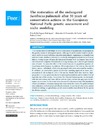Please use this identifier to cite or link to this item:
https://accedacris.ulpgc.es/jspui/handle/10553/41464
| Title: | The restoration of the endangered Sambucus palmensis after 30 years of conservation actions in the Garajonay National Park: genetic assessment and niche modeling | Authors: | Rodríguez Rodríguez, Priscila Fernández de Castro, Alejandro G. Sosa, Pedro A. |
UNESCO Clasification: | 241713 Ecología vegetal 2417 Biología vegetal (botánica) |
Keywords: | Computer-Program Population-Size Endemic Flora Diversity Rescue, et al |
Issue Date: | 2018 | Journal: | PeerJ | Abstract: | The translocation of individuals or the reinforcement of populations are measures in the genetic rescue of endangered species. Although it can be controversial to decide which and how many individuals must be reintroduced, populations can benefit from reinforcements. Sambucus palmensis is a critically endangered endemic to the Canary Islands. During the past 30 years, the Garajonay National Park (La Gomera) has carried out an intensive program of translocations using cuttings, due to the low germination rates of seeds. To assess the effect of the restorations on the population genetics of S. palmensis in La Gomera, we collected 402 samples from all the restored sites and all known natural individuals, which were genotyped with seven microsatellite markers. In addition, we conducted a species distribution modeling approach to assess how restorations fit the ecological niche of the species. Results show that there is a high proportion of clone specimens due to the propagation method, and the natural clonal reproduction of the species. Nonetheless, the observed heterozygosity has increased with the restorations and there still are private alleles and unique genotypes in the natural populations that have not been considered in the restorations. The population of Liria constitutes a very important genetic reservoir for the species. To optimize future reintroductions, we have proposed a list of specimens that are suitable for the extraction of seeds or cuttings in a greenhouse, as well as new suitable areas obtained by the species distribution models. | URI: | https://accedacris.ulpgc.es/handle/10553/41464 | ISSN: | 2167-8359 | DOI: | 10.7717/peerj.4985 | Source: | PeerJ [ISSN 2167-8359], v. 2018 (e4985) |
| Appears in Collections: | Artículos |
SCOPUSTM
Citations
6
checked on Jun 8, 2025
WEB OF SCIENCETM
Citations
6
checked on Jun 8, 2025
Page view(s)
103
checked on May 4, 2024
Download(s)
96
checked on May 4, 2024
Google ScholarTM
Check
Altmetric
Share
Export metadata
Items in accedaCRIS are protected by copyright, with all rights reserved, unless otherwise indicated.
